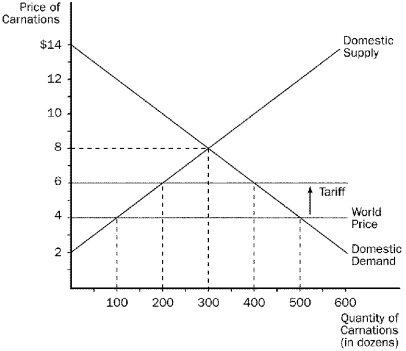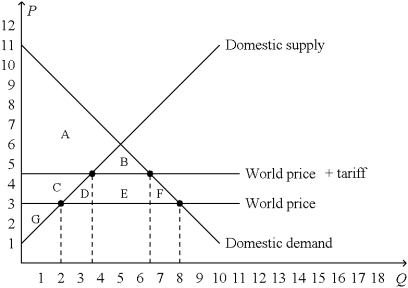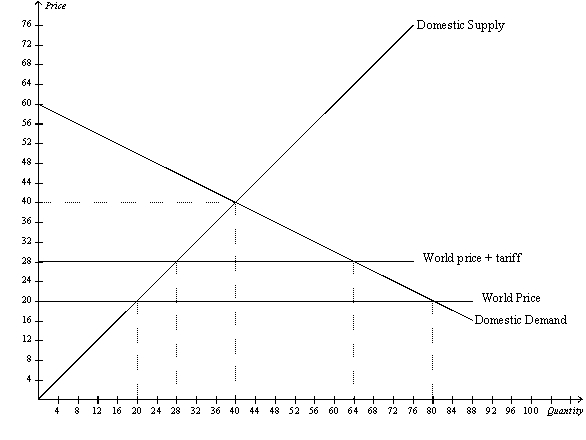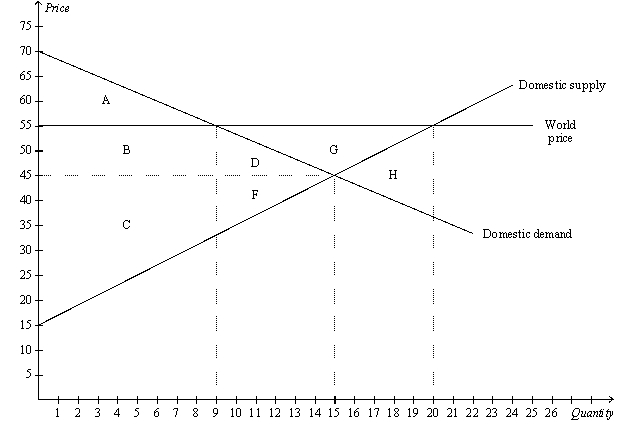A) increases by the area B + D.
B) increases by the area B + D + G.
C) decreases by the area C + F.
D) decreases by the area G.
F) B) and C)
Correct Answer

verified
Correct Answer
verified
Multiple Choice
Chile allows trade with the rest of the world. We know that Chile has a comparative advantage in producing lemons if we know that
A) Chile imports lemons.
B) the world price of lemons is higher than the price of lemons that would prevail in Chile if trade with other countries were not allowed.
C) consumer surplus in Chile would exceed producer surplus in Chile if trade with other countries were not allowed.
D) All of the above are correct.
F) None of the above
Correct Answer

verified
Correct Answer
verified
Multiple Choice
Figure 9-6  -Refer to Figure 9-6. When the tariff is imposed, domestic consumers
-Refer to Figure 9-6. When the tariff is imposed, domestic consumers
A) lose by $500.
B) lose by $900.
C) gain by $500.
D) gain by $900.
F) None of the above
Correct Answer

verified
Correct Answer
verified
True/False
Economists view free trade as a way to raise living standards both at home and abroad.
B) False
Correct Answer

verified
Correct Answer
verified
Multiple Choice
When a country allows international trade and becomes an importer of a good,
A) domestic producers of the good become better off.
B) domestic consumers of the good become worse off.
C) the gains of the winners exceed the losses of the losers.
D) All of the above are correct.
F) C) and D)
Correct Answer

verified
Correct Answer
verified
Multiple Choice
Figure 9-16. The figure below illustrates a tariff. On the graph, Q represents quantity and P represents price.  -Refer to Figure 9-16. The deadweight loss created by the tariff is represented by the area
-Refer to Figure 9-16. The deadweight loss created by the tariff is represented by the area
A) B.
B) D + F.
C) D + E + F.
D) B + D + E + F.
F) A) and D)
Correct Answer

verified
Correct Answer
verified
Multiple Choice
If the demand curve and the supply curve for a good are straight lines, then the deadweight loss that results from a tariff is represented on the supply-and-demand graph by
A) the area of one triangle.
B) the area of one rectangle.
C) the combined areas of two different triangles.
D) the combined areas of two different rectangles.
F) C) and D)
Correct Answer

verified
Correct Answer
verified
True/False
The history of the textile industry raises important questions for economic policy.
B) False
Correct Answer

verified
Correct Answer
verified
Multiple Choice
A common argument in favor of restricting trade
A) concerns the strategy of bargaining.
B) is that efforts should be made to get new industries started.
C) emphasizes the belief that all countries should play by the same rules.
D) All of the above are correct.
F) A) and B)
Correct Answer

verified
Correct Answer
verified
Multiple Choice
Suppose Guatemala has an absolute advantage over other countries in producing sugar, but other countries have a comparative advantage over Guatemala in producing sugar. If trade in sugar is allowed, Guatemala
A) will import sugar.
B) will export sugar.
C) will either export sugar or export sugar, but it is not clear from the given information.
D) would have nothing to gain either from exporting or importing sugar.
F) A) and D)
Correct Answer

verified
Correct Answer
verified
True/False
Deadweight loss measures the decrease in total surplus that results from a tariff or quota.
B) False
Correct Answer

verified
Correct Answer
verified
Multiple Choice
In a December 2007 New York Times column, Paul Krugman noted that
A) it is difficult to find instances of trade between high-wage countries in the modern era.
B) it is difficult to find instances of trade between high-wage countries and low-wage countries in the modern era.
C) the United States now imports more oil and other raw materials from other advanced countries than from the third world.
D) the United States now imports more manufactured goods from the third world than from other advanced countries.
F) C) and D)
Correct Answer

verified
Correct Answer
verified
Multiple Choice
Figure 9-17  -Refer to Figure 9-17. With free trade, the country imports
-Refer to Figure 9-17. With free trade, the country imports
A) 16 units of the good.
B) 24 units of the good.
C) 60 units of the good.
D) 64 units of the good.
F) A) and C)
Correct Answer

verified
Correct Answer
verified
Multiple Choice
If a country allows trade and, for a certain good, the domestic price without trade is higher than the world price,
A) the country will be an exporter of the good.
B) the country will be an importer of the good.
C) the country will be neither an exporter nor an importer of the good.
D) Additional information is needed about demand to determine whether the country will be an exporter of the good, an importer of the good, or neither.
F) None of the above
Correct Answer

verified
Correct Answer
verified
True/False
If a country allows free trade and imports cars, then it is the case that the gains to domestic producers outweigh the losses to domestic consumers.
B) False
Correct Answer

verified
Correct Answer
verified
Multiple Choice
The before-trade price of fish in Germany is $8.00 per pound. The world price of fish is $6.00 per pound. Germany is a price-taker in the fish market. If Germany allows trade in fish, then Germany will become an
A) importer of fish and the price of fish in Germany will be $6.00.
B) importer of fish and the price of fish in Germany will be $8.00.
C) exporter of fish and the price of fish in Germany will be $6.00.
D) exporter of fish and the price of fish in Germany will be $8.00.
F) B) and C)
Correct Answer

verified
Correct Answer
verified
Multiple Choice
Which of the following is the most accurate statement?
A) Protection is necessary in order for young industries to grow up and be successful.
B) Protection is not necessary for an industry to grow.
C) Protection is necessary because if young industries are not protected, they may suffer losses.
D) Protection may not always be necessary for infant industries, but it has proven to be useful in most cases.
F) A) and C)
Correct Answer

verified
Correct Answer
verified
Multiple Choice
A logical starting point from which the study of international trade begins is
A) the recognition that not all markets are competitive.
B) the recognition that government intervention in markets sometimes enhances the economic welfare of the society.
C) the principle of absolute advantage.
D) the principle of comparative advantage.
F) All of the above
Correct Answer

verified
Correct Answer
verified
Multiple Choice
President Bush imposed temporary tariffs on imported steel in 2002. The reasons for this trade restriction is most consistent with the
A) national-security argument.
B) infant-industry argument.
C) unfair competition argument.
D) protection-as-a-bargaining chip-argument.
F) A) and C)
Correct Answer

verified
Correct Answer
verified
Multiple Choice
Figure 9-1
The figure illustrates the market for wool in Scotland.  -Refer to Figure 9-1. When trade is allowed,
-Refer to Figure 9-1. When trade is allowed,
A) Scotland producers of wool become better off and Scotland consumers of wool become worse off.
B) Scotland consumers of wool become better off and Scotland producers of wool become worse off.
C) both Scotland producers and consumers of wool become better off.
D) both Scotland producers and consumers of wool become worse off.
F) B) and C)
Correct Answer

verified
Correct Answer
verified
Showing 361 - 380 of 409
Related Exams